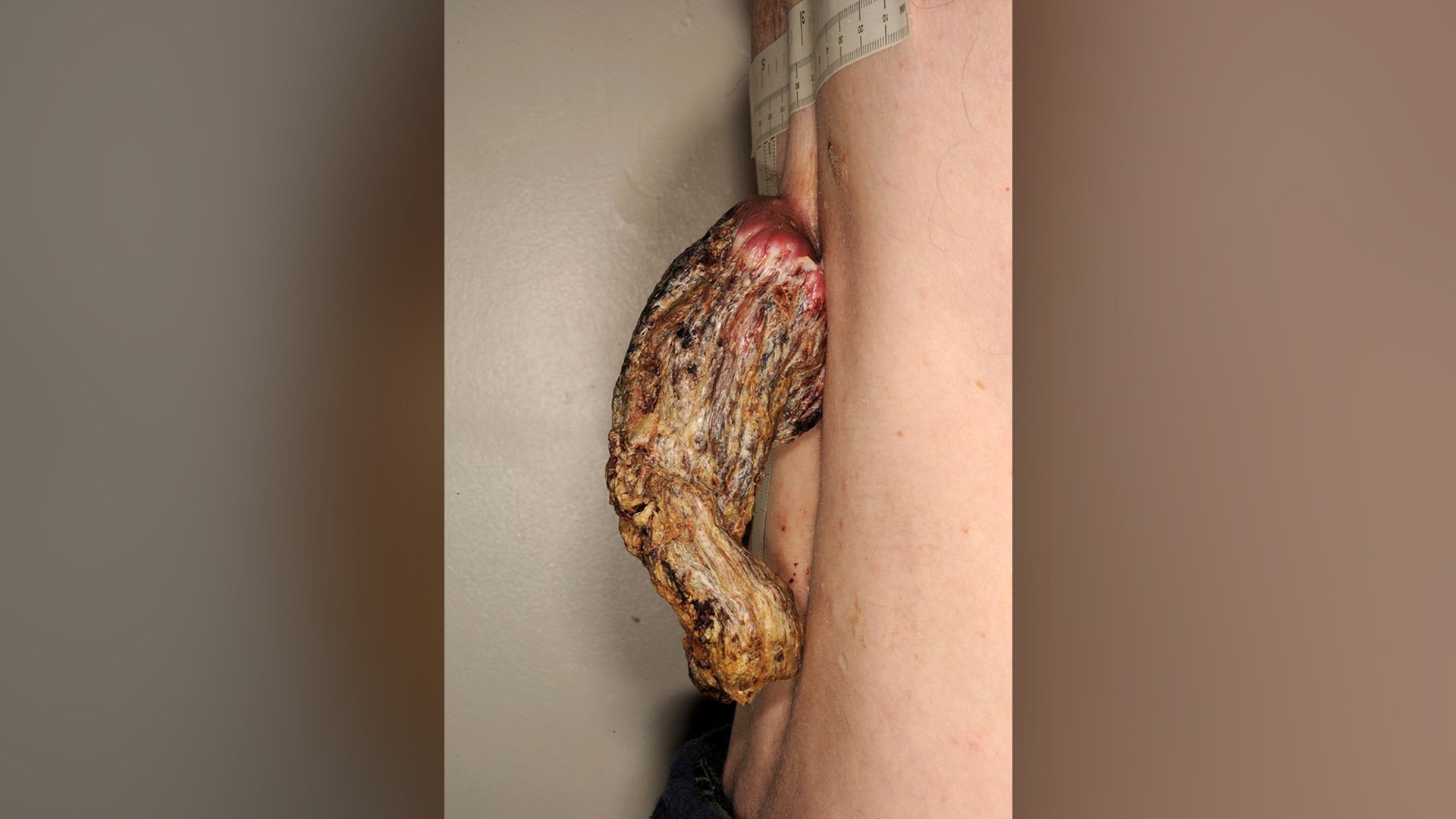5-Inch-Long 'Dragon's Horn' Grows from Man's Back
The enormous growth began as a lesion that steadily expanded over several years.

A brownish-yellow, hardened skin growth on a man's back grew to such massive proportions that it resembled a giant dragon's horn by the time surgeons finally removed it.
The so-called horn started out humbly as a rough, scaly lesion that first appeared in the middle of a 50-year-old man's back years ago, according to findings published online in the December 2019 issue of the journal BMJ Case Reports.
Over the next three years, the patch of toughened skin grew progressively bigger. Eventually, it formed a thick, curved, horn-like structure that extended nearly to the man's waist; at the time of its removal, the growth measured 5.5 inches (140 millimeters) long and over 2 inches (60 mm) wide, reaching just over 2 inches (55 mm) thick.
Related: 27 Oddest Medical Cases
Conical "horns" such as these, also known as cutaneous horns, consist of compacted keratin and are most commonly found in patients from the ages of 60 to 70 years old, according to the dermatology website DermNet NZ. While cutaneous horns can form anywhere on the body, they typically appear in places that are exposed to the sun, such as the head and ears, the backs of hands, and the forearms.
Cutaneous horns are generally small, but some — such as the recently excised back horn — can reach astonishing proportions. One famous example, preserved and exhibited in The Mütter Museum of The College of Physicians of Philadelphia, measures approximately 8 inches (20 centimeters) long and was removed from a 70-year-old woman and donated to the museum in the 1940s.
Another human horn in The Mütter Museum's collection is displayed on a wax figure that was sculpted from a living model. This horn belonged to a 19th-century French woman known as Madame Dimanche, and the structure measured nearly 10 inches (25 cm) long.
Get the world’s most fascinating discoveries delivered straight to your inbox.
Cancer link
Horn-like growths are often associated with skin cancer, and in nearly 16% of those cases, the cancer is malignant, according to the case report. In the current case, after surgeons removed the growth, they closed the wound with a skin graft from the man's thigh. When they examined the mass, they identified squamous cell carcinoma, a type of skin cancer caused by the runaway growth of cells that make up the epidermis, the skin's outermost layer.
While the patient didn't have a family history of skin cancer or a personal history of excessive sun exposure, he had fair skin and was a smoker, placing him in a higher-risk group for developing a malignant growth, according to the report.
The horn likely grew to be as big as it did only because its owner neglected to treat it for several years, even though he lived "in a developed country with access to free health care," the authors remarked. The surgery to remove the man's horn took place in the United Kingdom.
"This highlights that, despite current public skin-cancer awareness and rigorous health care measures, cases like this can still arise and slip through the net," the authors wrote.
- 7 Cancers You Can Ward Off with Exercise
- How to Fix 9 Common Skin Problems
- 27 Devastating Infectious Diseases
Originally published on Live Science.

Mindy Weisberger is a science journalist and author of "Rise of the Zombie Bugs: The Surprising Science of Parasitic Mind-Control" (Hopkins Press). She formerly edited for Scholastic and was a channel editor and senior writer for Live Science. She has reported on general science, covering climate change, paleontology, biology and space. Mindy studied film at Columbia University; prior to LS, she produced, wrote and directed media for the American Museum of Natural History in NYC. Her videos about dinosaurs, astrophysics, biodiversity and evolution appear in museums and science centers worldwide, earning awards such as the CINE Golden Eagle and the Communicator Award of Excellence. Her writing has also appeared in Scientific American, The Washington Post, How It Works Magazine and CNN.


